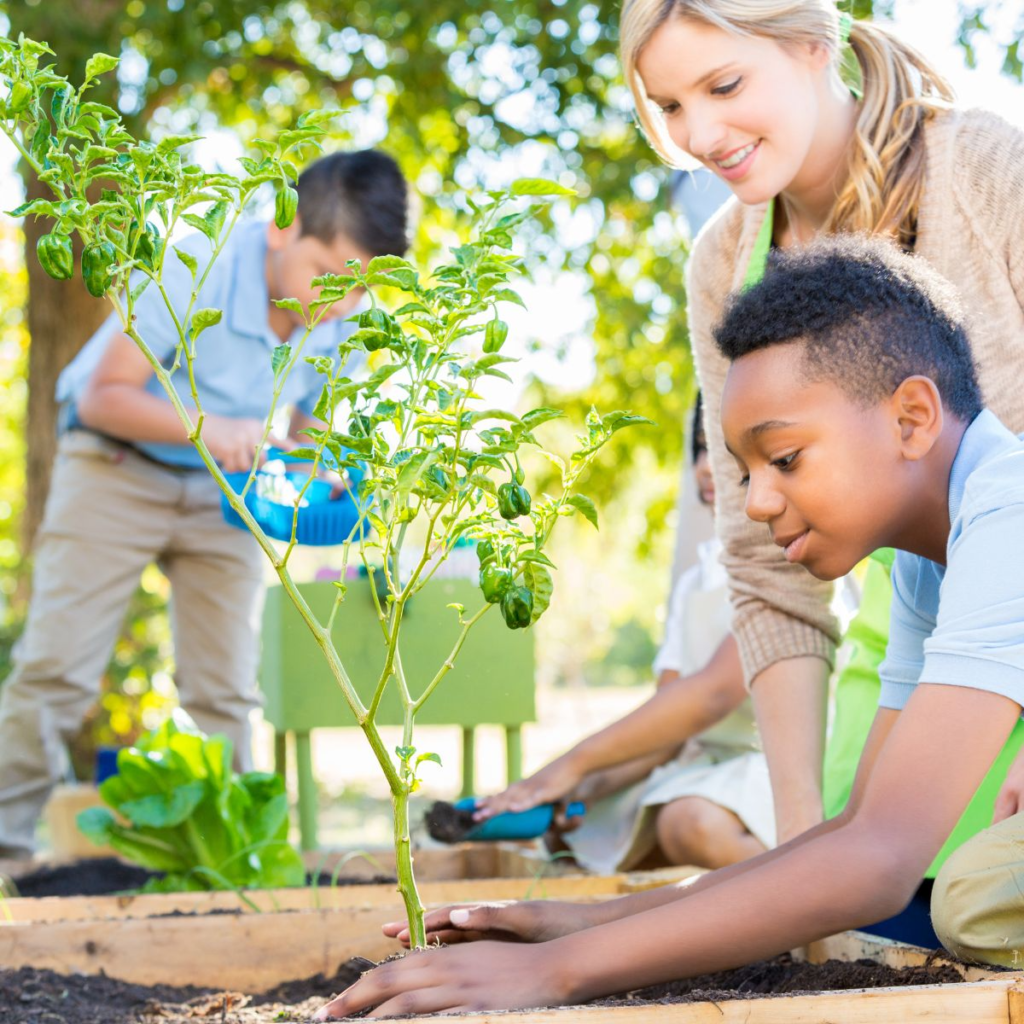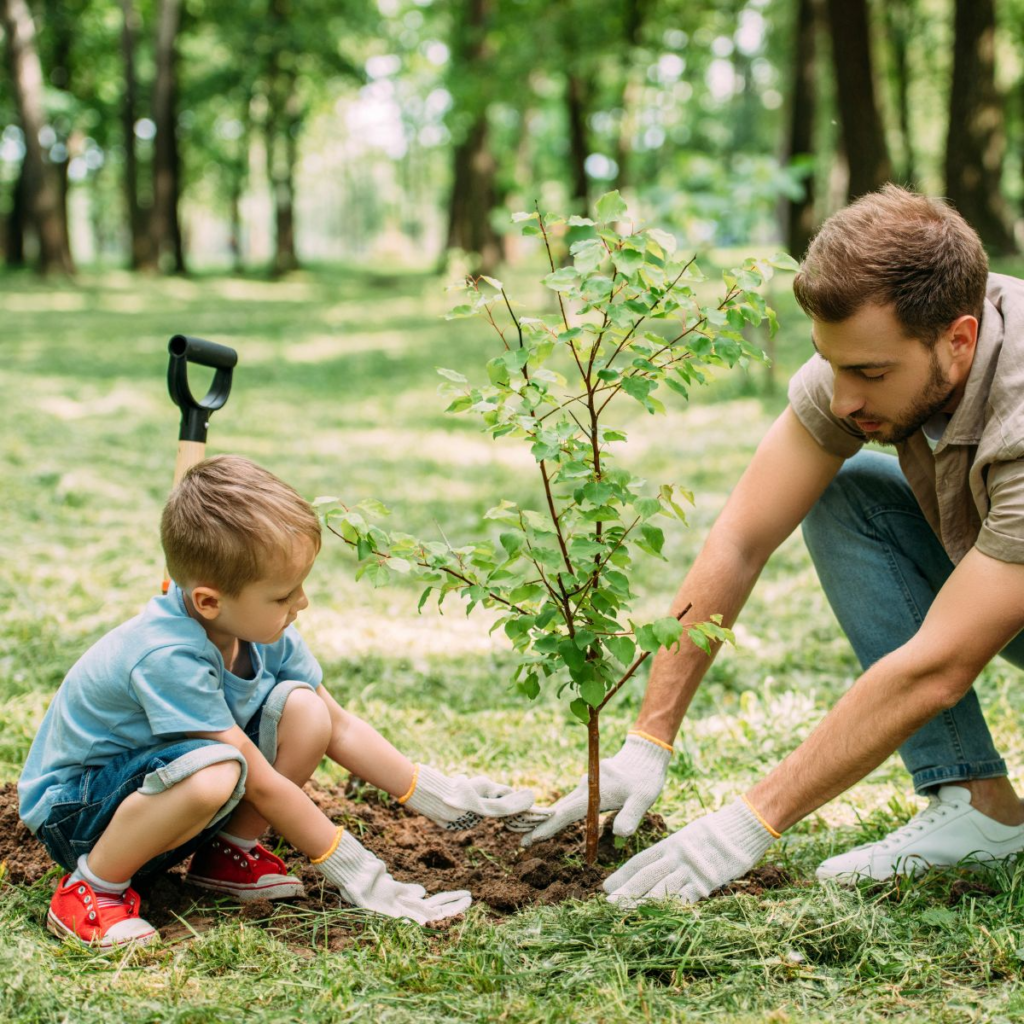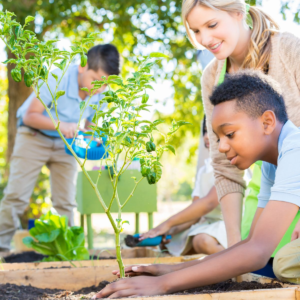
How often do we observe trees around us? In our day-to-day lives whether we are walking the kids to school or commuting to work, do we stop and look at the trees around us?
Trees play a significant role in our lives by providing us with oxygen, improving air quality, supporting biodiversity, and providing resources that are essential for human life and the environment. If you’re a parent, caregiver, or educator who acknowledges the importance of trees for our planet, you probably understand the role trees play in children’s lives. Your appreciation for nature can have a positive impact on a child’s growth and teach them about caring for the planet in their younger years.
Introducing children to trees and encouraging them to participate in tree-planting activities is a step towards promoting an eco-friendly lifestyle in their early years.
When children become involved with nature and take part in these activities, they develop a passion and knowledge for the planet, which can lead to increased environmental awareness and care. Planting a tree while growing up has numerous benefits for children, connecting them to the environment and fostering a sense of responsibility for their well-being.
Tree Planting and the Global Root of the Problem
We are all familiar with the effects of deforestation, especially in recent years. Globally, the effects of deforestation have taken their toll on the planet and impacted negatively against climate change.
Trees absorb carbon dioxide from the atmosphere and store it as carbon, helping to mitigate the effects of greenhouse gas emissions. However, when trees are cut down or burned, the carbon stored within them is released back into the atmosphere as carbon dioxide, contributing to the greenhouse effect and speeding up climate change.

Deforestation also reduces the planet’s capacity to absorb carbon dioxide, further worsening the problem. Additionally, deforestation destroys wildlife habitats, reduces biodiversity, and can lead to soil erosion, affecting the livelihoods of local communities and damaging the ecosystem.
According to the WWF, forest loss and damage are the cause of around 10% of global warming.
We need to protect our forests and plant more trees than ever.
In a study conducted by Yale University annually, we lose approximately 15 billion trees globally due to deforestation and plant around 5 billion.
Every year, we lose approximately 10 billion trees, which equates to an area of forest the size of a football field disappearing every second. If deforestation continues at this rate, the earth’s current stock of approximately 3.04 trillion trees will be depleted within 300 years.
Six Facts About Trees for Kids
- A single mature tree can provide enough oxygen for a family of four to breathe for an entire year.
- Trees contribute to cooling the earth by lowering temperatures through the shade they provide and the cooling effect of the air and ground around them.
- Research has shown that hospital patients with a view of trees from their room tend to recover faster than those without.
- Studies have shown that spending time in nature, including around trees, can reduce stress, improve mood, and promote physical health.
- Trees provide valuable resources such as timber, fruits, nuts, and medicinal plants, supporting local economies and contributing to sustainable development.
- Trees are natural air purifiers, they absorb harmful pollutants and release oxygen, improving air quality and reducing the risk of respiratory diseases.
What Are the Tree-Planting Initiatives Taking Place Globally?
The earth is losing trees at an alarming rate, especially in the Global South. According to a report by the UN, South America, and Africa have suffered greatly from deforestation. As of 2015, South Africa had lost 3.6 million hectares of trees while Africa lost 3.2 million hectares.
The Great Green Wall Africa
The Great Green Wall initiative is an African-led project aimed at creating a green belt of trees and vegetation across the Sahel region of Africa, stretching from Senegal in the west to Djibouti in the east. The initiative, launched in 2007, aims to combat desertification, land degradation, and climate change while promoting food security, job creation, and sustainable development in the region. The project involves planting a mix of native trees and crops and creating a mosaic of greenery that can provide multiple benefits, including reducing soil erosion, conserving water, improving soil fertility, and providing habitat for wildlife. The initiative also involves the participation of local communities engaged in tree planting, water management, and sustainable land use practices. Its goal is to restore 100 million hectares of degraded land by 2030.
According to the UN as of 2023, this initiative has already led to the successful completion of 18% of the great green wall.
Adopt a Park Program
The largest tree-planting initiative in South America is the Brazilian government’s Adopt a Park program. It was launched in 2020 and aims to restore and protect 4.8 million hectares of degraded land in the Amazon rainforest by 2030 through a combination of tree planting, forest conservation, and sustainable land use practices.
The Adopt-a-Park Program facilitates the investment of resources by the adopter towards services like remote monitoring, wildland firefighting and prevention, combating illegal deforestation, and restoring degraded areas. The goal of the program is not only to restore degraded land but also to provide sustainable livelihoods for local communities through the use of sustainable forest management practices.

What’s Being Done in the UK and How Can We Get Children Involved?
According to the Forestry Commission figures in the UK, only 13% of the land is currently forested, which is significantly lower than the average of 35% across the rest of Europe.
Deforestation in the UK has mainly resulted from urbanization, and the construction of new homes, roads, and amenities. Although timber production in the UK mostly depends on sustainable forests, it has contributed significantly to the depletion of forests and woodlands throughout the U.K.
Free Trees for Schools and Communities Initiative by the Woodland Trust
The Woodland Trust’s Free Trees initiative is a fantastic opportunity for schools and communities in the UK to receive ‘free trees to plant’ in their local area. This initiative aims to promote the planting of trees and increase awareness of the many benefits they provide, including carbon sequestration, air quality improvement, and biodiversity conservation. Schools and community groups can apply for packs of trees specifically chosen to suit the local environment and provide a range of benefits.
The initiative is open to all schools and community groups in the UK, and the Woodland Trust guides how to plant and care for the trees.
By participating in this initiative, schools and communities can contribute to the fight against climate change and make a positive impact on their local environment.
The woodland trust aims to get 50 million trees in the ground over the next 5 years, as of 2021 they had sent out 600,000 trees to be planted in schools and communities throughout the U.K.
You can apply via the Woodland Trust website. Tree packs are delivered twice a year during tree planting season in March and November.

Benefits of Planting Trees With Children
Children possess a great passion for and knowledge of climate change and its primary causes. They are also enthusiastic about participating in projects that can reduce their community’s carbon footprint. Planting trees is a simple way to engage kids and make a positive contribution to the environment.
- Trees are an essential part of the environment, and planting trees can help children understand the importance of maintaining a healthy ecosystem. When children learn about the positive impact of planting trees, they can develop a sense of responsibility towards the environment.
- Planting trees can help promote sustainable living by reducing carbon emissions, mitigating climate change, and conserving natural resources. Children who learn about the benefits of planting trees can make informed choices about their lifestyle and contribute towards a sustainable future.
- Planting trees can be a social responsibility, as it helps build community awareness and promotes collective action towards a common goal. Children who learn about the importance of planting trees can develop a sense of social responsibility and contribute towards building a better society.
- Aside from the evident environmental advantages, planting trees can also bring about positive effects on the mental health of children. Research studies have highlighted that the opportunity to play and learn in outdoor environments has a significant positive impact on children.
- Encouraging physical activity among children can enhance their overall health and well-being, while also making learning more engaging by providing an enjoyable setting. Also planting trees adds to a nice setting for your garden, community, or school.
Benefits of Outdoor Activities With Children
According to a report by the National Trust, modern children may be experiencing a phenomenon called “nature deficit disorder” due to their lack of outdoor exposure.
Tim Gill, a prominent voice on childhood development, emphasized the importance of spending time in natural environments, stating that these places provide a unique and stimulating experience that enhances children’s lives. Through exposure to the natural world, children can develop a deeper understanding of themselves, their capabilities, and their relationship with the world around them.
As a parent, you may wonder about the benefits of taking your children to the woods. While it’s tempting to keep children indoors, it’s essential to understand that nature offers significant benefits for their development.
Here are some of the key reasons why getting out and about in the woods with children is so important:
Spending time outdoors in the woods provides an excellent opportunity for children.
- Physical health: Engage in physical activity, such as running, jumping, and climbing. This helps to develop their motor skills, improve their coordination, and increase their overall fitness levels.
- Mental health: Reduce stress. The tranquillity of the woods can help children feel calm, relaxed, and at peace, which is especially important in today’s fast-paced world.
- Imagination and creativity: They can invent their games, build forts, and create stories about the animals and plants they encounter.
- Education: Observe and Learn about the natural world – the different plants and animals, the water cycle, and the effects of human impact on the environment which can spark a lifelong interest in the environment and conservation.
Spending time in the woods also strengthens the bond between parents and children. Things To Do in Our Woods – Woodland Trust
Additionally, children can learn about the importance of trees and the environment through activities such as identifying different species, examining leaves and bark, and learning about the role trees play in our ecosystem.
Encouraging your children to spend time in the woods is a valuable investment in their overall well-being and development.
Our Call to Action
Get your children involved in exploring the wonders of nature!
Take them to the woods, identify different tree species, examine leaves and bark, and uncover the vital role trees play in our ecosystem.
This investment in their well-being and development will leave a lasting impact.
Start the journey today! Share your thoughts in the comment section below





